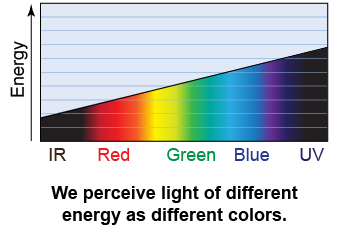|
Light is a form of radiant energy that is all around us. Radiant energy has no mass and can travel unimpeded through the vacuum of space. Visible light is a small part of the whole spectrum of radiant energy that includes microwaves, infrared radiation, and ultraviolet light—as well as more exotic forms such as x-rays and gamma rays. The human eye responds to a narrow band of energy that starts in the dull red, then proceeds through orange, yellow, green, blue, and violet. Violet is the most energetic light you can see. Light of higher energy falls into the ultraviolet (UV) range and it can give you a sunburn, but you cannot see it with your eyes. 
|

|
Radiant energy always travels at the speed of light, which is 300,000,000 m/s. Nothing in the known universe can travel faster than light. Since light is energy that is always moving, it is best described in terms of its power. An old-fashioned, incandescent 100 W light bulb produces a power output of about 2 or 3 W of visible light; the remaining input power is transformed into thermal energy. The Sun produces an incredible amount of power—about 3.8×1026 W. 
 |
 Fans of science fiction books and movies know that many stories include a technology—such as a warp drive!—by which the characters can travel across the Galaxy faster than the speed of light. In the real world, can anything actually travel faster than light? No! Light is massless, and only things that are massless can travel at the speed of light; everything else has mass and must travel slower. This is a basic postulate of Albert Einstein's theory of special relativity.
Fans of science fiction books and movies know that many stories include a technology—such as a warp drive!—by which the characters can travel across the Galaxy faster than the speed of light. In the real world, can anything actually travel faster than light? No! Light is massless, and only things that are massless can travel at the speed of light; everything else has mass and must travel slower. This is a basic postulate of Albert Einstein's theory of special relativity. 
|
Intensity is power per unit area. An intensity of 1 watt per square meter (1 W/m2) means 1 W of light power crosses or lands on each square meter of surface. When we say a light is bright or dim, what we really mean is that the intensity of the light is either low (dim) or high (bright). The intensity of bright sunlight can be as high as 600 W/m2. Thus sunlight delivers the energy of six 100 W light bulbs onto every square meter of the Earth. This is the reason why solar energy has great potential as a renewable energy source. 
|
Your eye is an incredibly sensitive detector of light energy. The light receptor cells in the back of your retina can detect an intensity of 10−9 W/m2, one billionth of a watt per square meter. Since the area of the retina is very small, this corresponds to a power of less than a trillionth of a watt! 
|
 Apart from whether the light is bright or dim, light has an intrinsic energy that produces the perception of color in your eye. The sensation of color is created by the brain in response to the differing energy content in the light. The lowest energy light humans can see is dull red. The highest energy light you can see is violet. A human eye is most sensitive to green light, which is in the middle of the visible energy spectrum. What we perceive as white light is actually an even mixture of light of different energies.
Apart from whether the light is bright or dim, light has an intrinsic energy that produces the perception of color in your eye. The sensation of color is created by the brain in response to the differing energy content in the light. The lowest energy light humans can see is dull red. The highest energy light you can see is violet. A human eye is most sensitive to green light, which is in the middle of the visible energy spectrum. What we perceive as white light is actually an even mixture of light of different energies. 
|
Which color light has more intrinsic energy, red or blue?
 |
Blue light has more intrinsic energy than red light as can be seen in the illustration above. 
|

